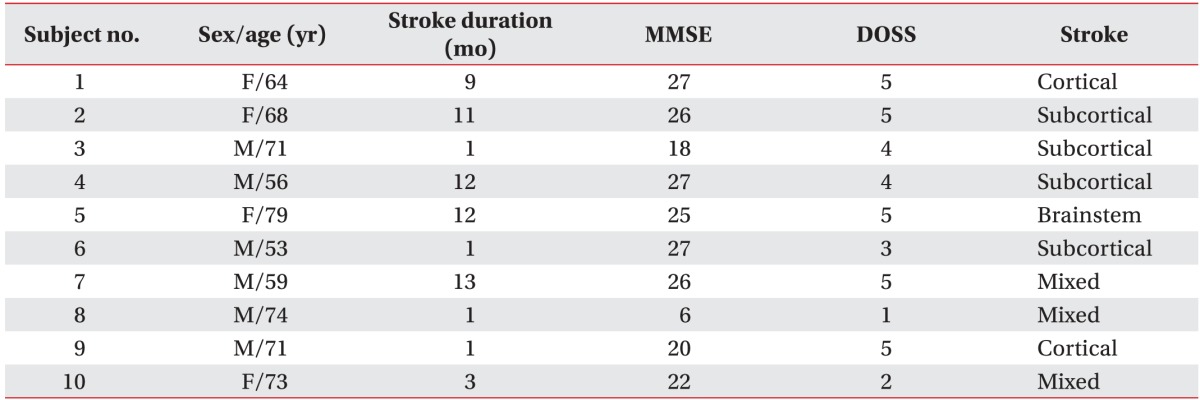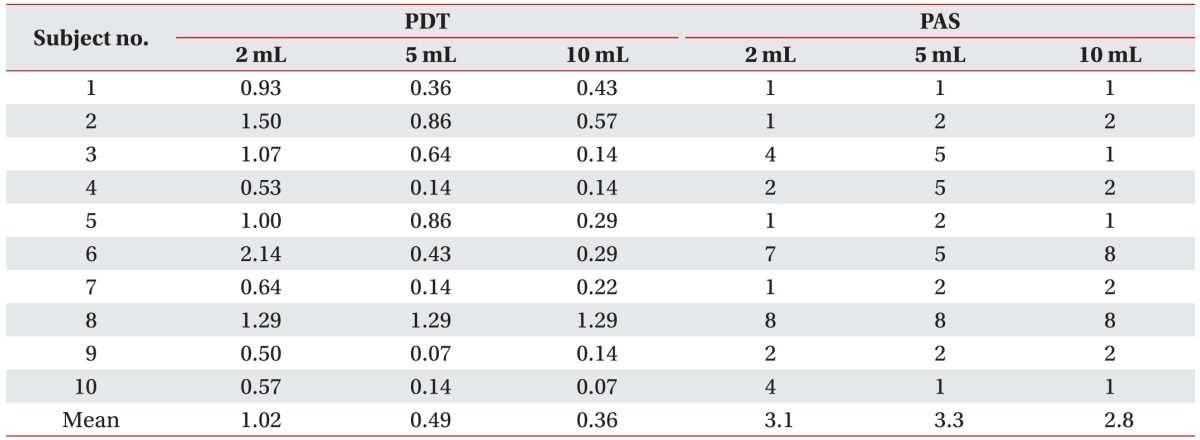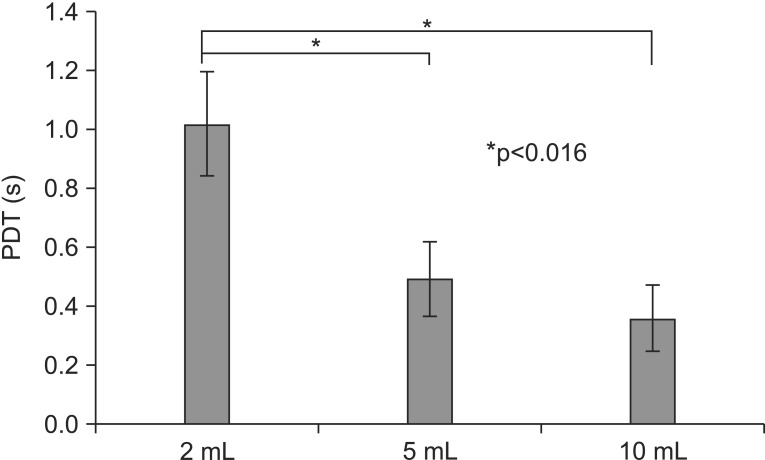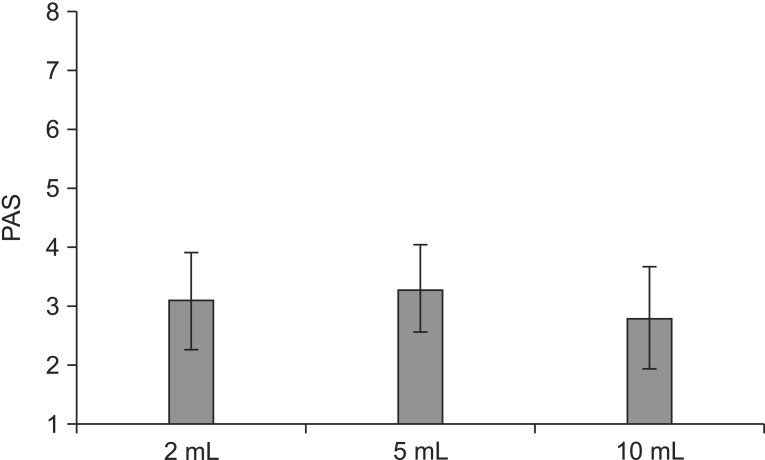1. Logemann JA. Evaluation and treatment of swallowing disorders. 2nd ed. Austin: Pro-ED;1998. p. 77–113. p. 307–314.
2. Kim Y, McCullough GH, Asp CW. Temporal measurements of pharyngeal swallowing in normal populations. Dysphagia. 2005; 20:290–296. PMID:
16633874.

3. Veis SL, Logemann JA. Swallowing disorders in persons with cerebrovascular accident. Arch Phys Med Rehabil. 1985; 66:372–375. PMID:
4004534.
4. Mann G, Hankey GJ, Cameron D. Swallowing function after stroke: prognosis and prognostic factors at 6 months. Stroke. 1999; 30:744–748. PMID:
10187872.
5. Perlman AL, Booth BM, Grayhack JP. Videofluoroscopic predictors of aspiration in patients with oropharyngeal dysphagia. Dysphagia. 1994; 9:90–95. PMID:
8005013.

6. Rofes L, Cola PC, Clave P. The effects of sensory stimulation on neurogenic oropharyngeal dysphagia. J Gastroenterol Hepatol Res. 2014; 3:1066–1072.
7. Lazarus CL, Logemann JA, Rademaker AW, Kahrilas PJ, Pajak T, Lazar R, et al. Effects of bolus volume, viscosity, and repeated swallows in nonstroke subjects and stroke patients. Arch Phys Med Rehabil. 1993; 74:1066–1070. PMID:
8215858.

8. Rosenbek JC, Robbins JA, Roecker EB, Coyle JL, Wood JL. A penetration-aspiration scale. Dysphagia. 1996; 11:93–98. PMID:
8721066.

9. Bisch EM, Logemann JA, Rademaker AW, Kahrilas PJ, Lazarus CL. Pharyngeal effects of bolus volume, viscosity, and temperature in patients with dysphagia resulting from neurologic impairment and in normal subjects. J Speech Hear Res. 1994; 37:1041–1059. PMID:
7823550.

10. Oommen ER, Kim Y, McCullough G. Stage transition and laryngeal closure in poststroke patients with dysphagia. Dysphagia. 2011; 26:318–323. PMID:
21085995.

11. Dantas RO, Kern MK, Massey BT, Dodds WJ, Kahrilas PJ, Brasseur JG, et al. Effect of swallowed bolus variables on oral and pharyngeal phases of swallowing. Am J Physiol. 1990; 258(5 Pt 1):G675–G681. PMID:
2333995.

12. Sible E, Perlman AL, He X. Effects of age, gender, bolus volume and viscosity on acoustic signals of normal swallowing. Turk J Phys Med Rehab. 2007; 53:94–99.
13. Gumbley F, Huckabee ML, Doeltgen SH, Witte U, Moran C. Effects of bolus volume on pharyngeal contact pressure during normal swallowing. Dysphagia. 2008; 23:280–285. PMID:
18253791.

14. Hoffman MR, Ciucci MR, Mielens JD, Jiang JJ, McCulloch TM. Pharyngeal swallow adaptations to bolus volume measured with high-resolution manometry. Laryngoscope. 2010; 120:2367–2373. PMID:
21108425.

15. Kahrilas PJ, Lin S, Chen J, Logemann JA. Oropharyngeal accommodation to swallow volume. Gastroenterology. 1996; 111:297–306. PMID:
8690194.

16. Kahrilas PJ, Logemann JA. Volume accommodation during swallowing. Dysphagia. 1993; 8:259–265. PMID:
8359048.

17. Lin T, Xu G, Dou Z, Lan Y, Yu F, Jiang L. Effect of bolus volume on pharyngeal swallowing assessed by high-resolution manometry. Physiol Behav. 2014; 128:46–51. PMID:
24518872.

18. Logemann JA. Preswallow sensory input: its potential importance to dysphagic patients and normal individuals. Dysphagia. 1996; 11:9–10. PMID:
8556885.

19. Teismann IK, Steinstrater O, Warnecke T, Suntrup S, Ringelstein EB, Pantev C, et al. Tactile thermal oral stimulation increases the cortical representation of swallowing. BMC Neurosci. 2009; 10:71. PMID:
19566955.

20. Lee SJ, Lee KW, Kim SB, Lee JH, Park MK. Voluntary cough and swallowing function characteristics of acute stroke patients based on lesion type. Arch Phys Med Rehabil. 2015; 96:1866–1872. PMID:
26184890.

21. O'Neil KH, Purdy M, Falk J, Gallo L. The dysphagia outcome and severity scale. Dysphagia. 1999; 14:139–145. PMID:
10341109.





 PDF
PDF ePub
ePub Citation
Citation Print
Print






 XML Download
XML Download